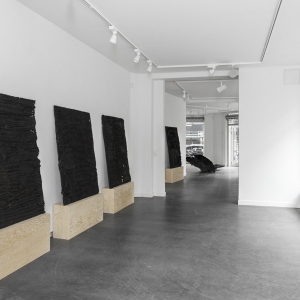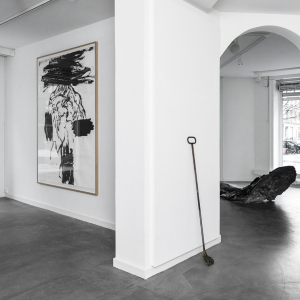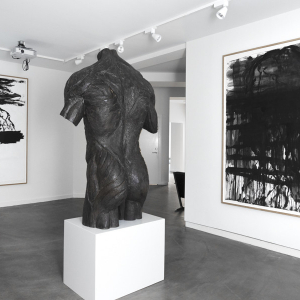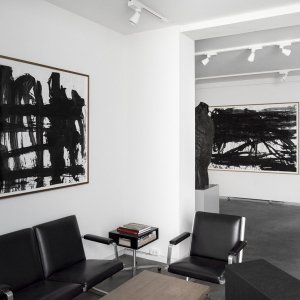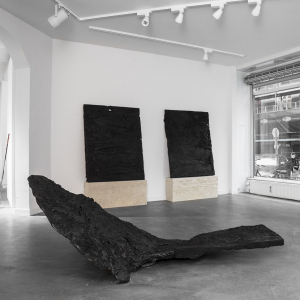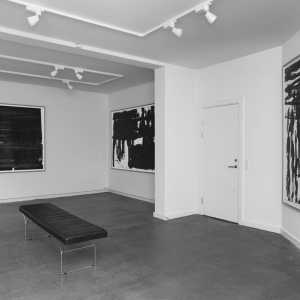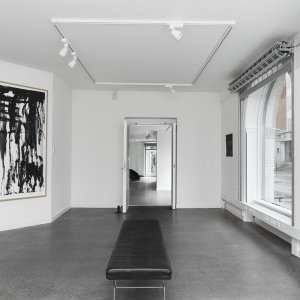Friday November 22, Christian Lemmerz’ new show “Uriel” opens in Hans Alf Gallery. For the infamous German, who turned sixty earlier this year, the exhibition marks a fundamental shift of gears, as he takes leave with his familiar figurative universe to instead explore the processual and performative in a series of monochrome and largely abstract drawings and reliefs.
Christian Lemmerz possesses an artistic mind quite out of the ordinary. One could easily argue that he has been one of the most dominant figures on the Danish art scene ever since the early 80’s. In crazy, grandiose and often grotesque visual manifestations, Lemmerz has time and time again taken his audience by surprise and pushed the boundaries of what is accepted in art. Through history, repetition and plagiarism has brought many singular minds to an understanding of the need for new vantage points, and in much the same way, Lemmerz’ practice seems to be driven by existential impatience: We have to forge on! And so, everything is unrooted, automatic reactions are dismantled, icons overthrown, darlings slain. The ground needs levelling, before new houses can be built.
In URIEL, Christian Lemmerz is in the middle of his own personal paradigm shift. After having spent most of his career exploring the narrative and aesthetic qualities of figuration, the sculptor-turned-draughtsman has for the past couple of years found himself mid-air in an artistic leap that has seen him reinvent his own universe: Gone are the anatomical studies, all the zombies and the biblical references; and what remains is the journey of the hand across the paper, a twilight between genesis and resolution, the quivering contour of a moment.
The journey towards a new understanding began shortly after Christian Lemmerz’ sorrowful exhibition “The Night is Large”, in which the artist processed the recent death of his parents through a series of portraits. According to Lemmerz, it felt as if he had finally emptied out his inner registry of images: The trembling profiles of his parents on their deathbeds, drawn from pure memory alone, marked a sort of farewell to figuration. In the months following his show, he still tried to find his way back, but while the artist yearned for everything universal and open to interpretation, his usual imagery appeared stale and banal to the artist. Lemmerz sought inspiration in oriental calligraphy and read everything, he could find about the subject. He hid away in his studio and initiated a tedious but determined transformation that didn’t find its true form until much later with the performance piece “EyeScape” at Copenhagen Contemporary.
Now, Christian Lemmerz has created a show that doesn’t look like anything, we’ve ever seen from him. Seven imposing, nonfigurative reliefs that are all made ”à la minute” like negative images, fingers directly in the foundry sand, freezing the movement with liquid bronze, are flanked by a series of subdued, monochrome “landscapes” that document the journey of the hand back and forth across the paper’s plane without resorting to recognizable shapes or imprints. A colossal bronze sculpture without a beginning or an end seems to have exploded into the room, and in smaller, grid-like drawings, one senses the inspiration from calligraphy. The ”old” Lemmerz is visible only in glimpses, as when an enormous bronze torso shoots up between a handful of drawings that also utilize the notion of the body as a more or less visible element. But, generally speaking, the gaze and the look has changed. And thus, also the experience.
As is customary with Lemmerz, what is at stake isn’t exactly clear. But in this particular show, it is perhaps an even greater pointe in itself that the room for interpretation and understanding is left open: It is essential that the audience gets involved and accepts the performative premise that informs the creation of the works, and thus, each spectator is forced to process the image itself, so that which is abstract can become concrete to each individual.
In Judaism and Catholicism, Uriel is the name of the fourth archangel after the better-known and more widely canonized Michael, Gabriel and Raphael. He is the angel of repentance and submission. In Milton’s ”Paradise Lost”, Uriel is in charge of the orb of the Sun, he is the eyes of God, but unwittingly steers Satan towards the newly created earth.

